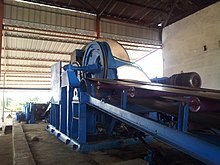Decorticator


A decorticator (from Latin: cortex, bark) is a machine for stripping the skin, bark, or rind off nuts, wood, plant stalks, grain, etc., in preparation for further processing.
History
In 1861, a farmer named Bernagozzi from Bologna manufactured a machine called a"scavezzatrice", a decorticator for hemp.[1] A working hemp decorticator from 1890, manufactured in Germany, is preserved in a museum in Bologna.[2]
Misconceptions about early versions of the device include the suggestion that the first working hemp decorticator was invented in the United States in 1935. In 1916, there were already five different kinds of "machine brakes" for hemp in use in the United States, and still others in Europe.[3]
In Italy, the"scavezzatrice" faded in the 1950s because of monopolisation from fossil fuel, paper interests, synthetic materials and from other less profitable crops.
Many types of decorticators have been developed since 1890.[4]
In 1919, George Schlichten received a U.S. patent on his improvements of the decorticator for treating fiber bearing plants.[5] Schlichten failed to find investors for production of his decorticator and died in 1923, a broken man.[6][7]
Newer, high-speed kinematic decorticators, use a different mechanism, enabling separation into three streams; bast fibre, hurd, and green microfiber.[8]
Current usage
In some decorticators, the operation is "semi-automatic", featuring several stops during operation, while more modern systems, such as high-speed kinematic decorticators, are fully automatic.
There are companies who produce and sell decorticators for different crops.[9][10]
References
- ^ Paolo Ranalli and Gianpietro Venturi: Hemp as a raw material for industrial applications, Euphytica, Euphytica 140: 1–6, 2004.
- ^ Picture of an 1890 GERMAN DECORTICATOR at Museo Della Civilta Contadina, San Marino Di Bentivoglio, Bologna, Italy.
- ^ Lyster H. Dewey: HEMP HURDS AS PAPER-MAKING MATERIAL. UNITED STATES DEPARTMENT OF AGRICULTURE, BULLETIN No. 404, 1916
- ^ Pictures of many decorticators in Internet
- ^ George W Schlichten, 1919
- ^ History of hemp prohibition
- ^ [1], V, Johansen John & C, Westergaard Carl, "Control mechanism for decorticating machines"
- ^ Canadian Greenfield Technologies Inc.; HempTrain
- ^ Canadian Greenfield Technologies Inc.; Decorticators
- ^ "IndiaMART InterMESH Limited; HempTrain". Archived from the original on 2011-10-03. Retrieved 2011-06-10.
